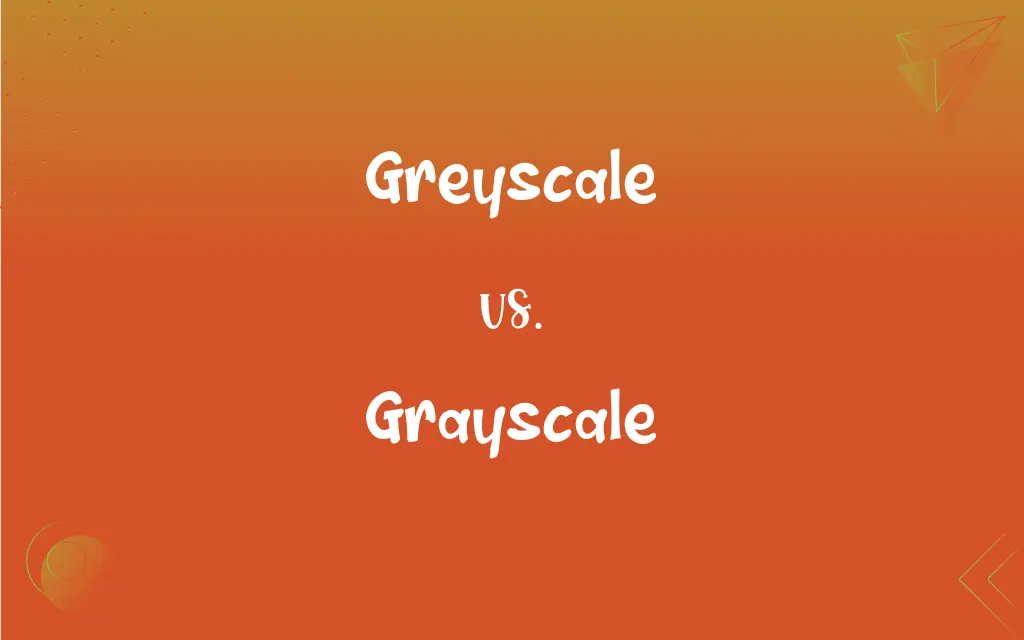Greyscale vs. Grayscale: What's the Difference?
By Harlon Moss & Janet White || Updated on March 4, 2024
"Greyscale" and "grayscale" refer to the same concept of images or displays in shades of gray, without color, differing only in spelling based on regional English variations—British English favors "greyscale," while American English prefers "grayscale."

Key Differences
Both "greyscale" and "grayscale" describe a color palette that includes only shades of gray, ranging from black to white, without any color. This concept is widely used in photography, printing, and digital display settings to represent images with varying intensities of light but no hue. The choice between "greyscale" and "grayscale" often depends on the regional spelling conventions of English, similar to other differences like "colour" vs. "color" or "favour" vs. "favor."
In digital imaging, greyscale/grayscale images are important for various applications, including artistic effects, reducing the complexity of image processing, and improving the legibility of certain types of visual information. These images are represented by assigning a brightness value to each pixel, rather than combining multiple colors (red, green, and blue) to create the image's colors.
The spelling variation does not imply any difference in meaning or application of the concept; it simply reflects the standard spelling preferences in different English-speaking countries. Regardless of spelling, the concept remains a fundamental part of visual arts, photography, and digital imaging technologies.
Comparison Chart
Definition
Images displayed in shades of gray, from black to white, without color.
Same as "greyscale," with an American English spelling.
Usage Context
Preferred in British English
Preferred in American English
ADVERTISEMENT
Applications
Photography, printing, digital displays
Same as "greyscale"
Importance
Used for artistic effects, simplicity in image processing, and legibility.
Same as "greyscale"
Spelling Variation
Reflects British English spelling conventions.
Reflects American English spelling conventions.
Greyscale and Grayscale Definitions
Greyscale
Used in printing to reduce costs.
The booklet was printed in greyscale to keep the production budget low.
Grayscale
A color mode in photography and digital imaging that contains only shades of gray.
The photographer edited the picture in grayscale to focus on its textures.
ADVERTISEMENT
Greyscale
A photographic technique focusing on light intensity.
The photographer captured the landscape in greyscale to emphasize texture.
Grayscale
The conversion of a color image to shades of gray to emphasize shape and light.
Converting the photo to grayscale highlighted its dramatic lighting.
Greyscale
Enhances legibility in certain displays.
The app uses a greyscale theme to reduce eye strain.
Grayscale
A visual representation technique in scientific and engineering data, where different shades of gray represent different values.
The seismic data was presented in grayscale to differentiate the layers of the Earth's crust.
Greyscale
Artistic choice in design.
The designer chose a greyscale palette to convey a sense of timelessness.
Grayscale
A method used in printing that simulates continuous tone imagery.
The grayscale print accurately reproduced the subtle tones of the original image.
Greyscale
Simplifies digital image processing.
Image analysis was performed on greyscale versions to speed up the algorithm.
Grayscale
A range of shades from black to white.
The artist's sketch used a grayscale to create depth and contrast.
Greyscale
Alternative spelling of grayscale.
Grayscale
A series of shades ranging from pure white to pure black, used in displaying monochromatic images.
Grayscale
An image displayed using such a series of shades.
Grayscale
(photography) A printed strip of graduated tones used to check exposure and development times.
Grayscale
(imaging) The use of black and white, representing color with shades of gray.
Grayscale
(imaging) Black and white, representing color with shades of gray.
Grayscale
(transitive) To convert to grayscale.
FAQs
Is there any technical difference between greyscale and grayscale images?
No, there is no technical difference; the terms are interchangeable and refer to the same concept of using shades of gray without color in images.
When should I use "greyscale" vs. "grayscale"?
Use "greyscale" when writing in British English contexts and "grayscale" for American English contexts, following the spelling conventions of your audience.
Why are greyscale/grayscale images important in digital processing?
They reduce computational complexity, making it easier and faster to process images for tasks such as pattern recognition, edge detection, and other image analysis applications.
How are greyscale/grayscale images created from color images?
They are created by converting the color values of each pixel to a single brightness value, typically using a formula that accounts for human perception of different colors' luminance.
Do greyscale/grayscale images use less storage space?
Yes, because they store only a single brightness value per pixel, unlike color images, which require multiple values (for red, green, and blue channels), leading to smaller file sizes.
Can all types of visual content be effectively represented in greyscale/grayscale?
While many types of images can be effectively represented, some content may lose important information without color, such as maps or charts that rely on color coding.
Can greyscale/grayscale images be converted back to color?
Original color information is lost in the conversion to greyscale/grayscale, making exact color restoration impossible without the original color data or additional colorization techniques.
Are there cultural or psychological effects associated with greyscale/grayscale imagery?
Yes, greyscale/grayscale imagery can evoke different emotional responses, often seen as more dramatic, timeless, or serious compared to color imagery.
How do artists and designers use greyscale/grayscale in their work?
Artists and designers use it to focus attention on composition, texture, and light, eliminating the distraction of color to convey specific moods or themes.
How does greyscale/grayscale imaging affect the perception of depth in photography?
Greyscale/grayscale imaging can enhance the perception of depth by emphasizing light, shadow, and texture, which may be less noticeable in color images.
What is the significance of greyscale/grayscale in film and television?
Greyscale/grayscale in film and television can convey a sense of history, emphasize mood and emotion, or distinguish certain narratives or themes within a story.
What role does greyscale/grayscale play in medical imaging?
It plays a crucial role in enhancing contrast and detail in images such as X-rays, MRIs, and CT scans, aiding in diagnosis and treatment planning.
How have perceptions of greyscale/grayscale imagery evolved with advances in color technology?
Despite advances in color technology, greyscale/grayscale imagery retains its appeal for its artistic and emotive qualities, often used to convey a timeless or classic aesthetic.
How do video games utilize greyscale/grayscale graphics?
Video games use greyscale/grayscale graphics to create a specific atmosphere, evoke nostalgia, or differentiate gameplay modes, enhancing the gaming experience.
What are the challenges in converting color images to greyscale/grayscale?
Challenges include maintaining contrast, preserving detail, and ensuring that color-coded information remains distinguishable in shades of gray.
What are the environmental impacts of printing in greyscale/grayscale vs. color?
Printing in greyscale/grayscale generally uses less ink or toner than color printing, potentially reducing environmental impact and printing costs.
Can greyscale/grayscale images be used for educational purposes?
Yes, they can simplify complex concepts, focus attention on specific details without the distraction of color, and are used in textbooks and educational materials.
How do greyscale/grayscale filters enhance social media content?
Greyscale/grayscale filters can add a dramatic or artistic quality to photos and videos, helping content stand out and convey a specific mood or style on social media platforms.
What advancements have been made in greyscale/grayscale imaging technology?
Advancements include high dynamic range greyscale imaging, which captures a greater range of light and shadow details, enhancing the depth and richness of greyscale photos and videos.
How does the human eye perceive greyscale/grayscale compared to color?
The human eye is more sensitive to variations in brightness than to color, making greyscale/grayscale imagery effective in highlighting contrasts and details.
About Author
Written by
Harlon MossHarlon is a seasoned quality moderator and accomplished content writer for Difference Wiki. An alumnus of the prestigious University of California, he earned his degree in Computer Science. Leveraging his academic background, Harlon brings a meticulous and informed perspective to his work, ensuring content accuracy and excellence.
Co-written by
Janet WhiteJanet White has been an esteemed writer and blogger for Difference Wiki. Holding a Master's degree in Science and Medical Journalism from the prestigious Boston University, she has consistently demonstrated her expertise and passion for her field. When she's not immersed in her work, Janet relishes her time exercising, delving into a good book, and cherishing moments with friends and family.































































